 Facebook
Facebook
 X
X
 Instagram
Instagram
 TikTok
TikTok
 Youtube
Youtube
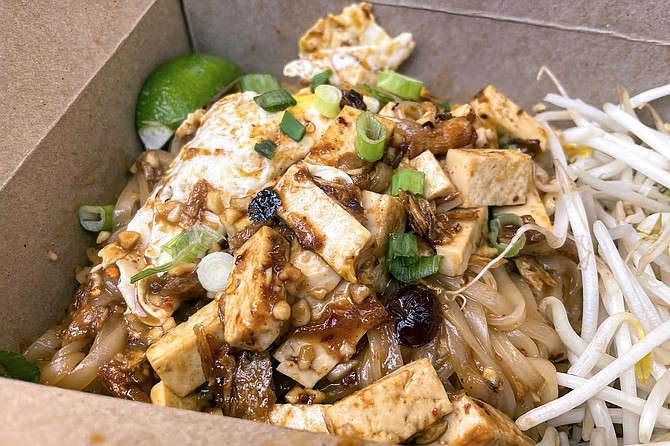
It had been a few years since I sought out a certain pad thai farmers market stand to receive a tasty lesson in Thai street food, and I felt overdue for a refresher course. However, I wasn’t sure where. Farmers market food vendors tend to bounce around. They’ll pop up at different weekly markets around the county, maybe just for a few weeks, or regularly for years — whatever best serves its business.
Only when I tried to pinpoint the current markets hosting The Pad Thai Stand did I realize that, sometime during the pandemic, the Thai noodle specialist had set up shop in a permanent, Clairemont Mesa location.
Pad Thai Stand still turns up at several farmers markets each week, including Oceanside, Del Mar, Pacific Beach, and the Sunday market at Lane Field, next to the waterfront. And its mission remains the same: to highlight the many possibilities of the humble pad thai. Though the Bangkok style is a staple of nearly every Thai restaurant in the U.S., the Stand’s founding chef Nattapon "Nat" Thitathan continues to travel Thailand to delve into dozens of regional variations, with an eye toward introducing distinctions to a local audience.
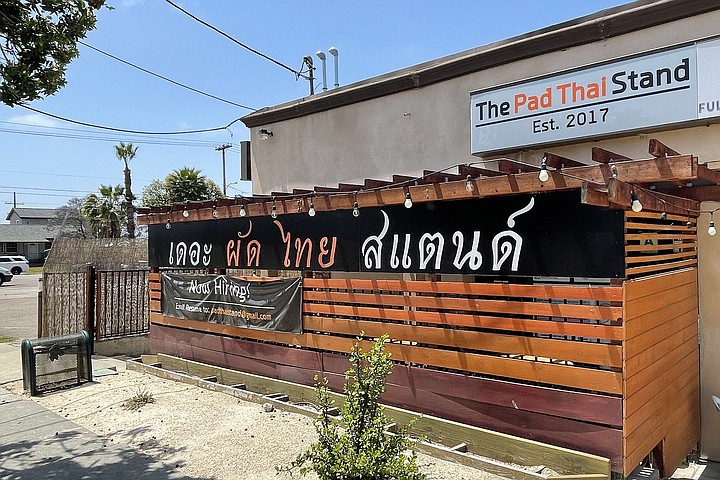
There’s no reason to feel overwhelmed, though. Only a handful of regional styles appear on the menu at Clairemont Mesa. In fact, at first blush, its offerings don’t appear all that different from the market stand.
You’ll find the central, Bangkok style we can think of as a base for pad thai, delivering a blend of tamarind paste, citrus, and fish sauce over rice noodles with egg, sprouts, and chili peppers to taste (from mild to spicy). Then, there’s the northern, Chiang-Mai style, embellished with peanut sauce and massaman curry; and the southern, Chai-Ya style, distinguished by coconut cream and crispy shallots.
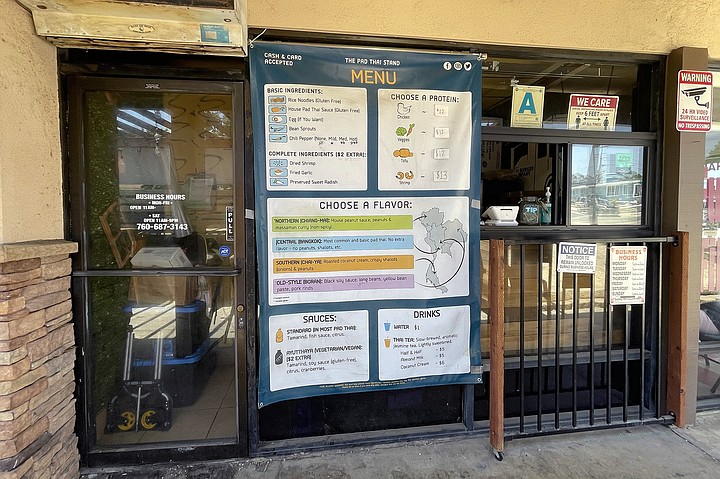
For $2 apiece, add-on toppings may include fried garlic, dried shrimp, or preserved sweet radish. For vegans and vegetarians, the base sauce for all three may be swapped for an Ayutthaya sauce (also $2) which replaces the anchovy fish sauce with additions of soy sauce and cranberries.
Where the storefront restaurant starts to deviate from the market stand is the addition of a fourth, boran style, which means it’s “old style” pad thai. This one starts with a black soy sauce, reduced in the pan, and gets topped differently, with both green and yellow beans, plus pork rinds. The mild sweetness brought by the soy pairs particularly well with the chili peppers, so I’d recommend it for heat-lovers who want to order in the medium and hot spice range.
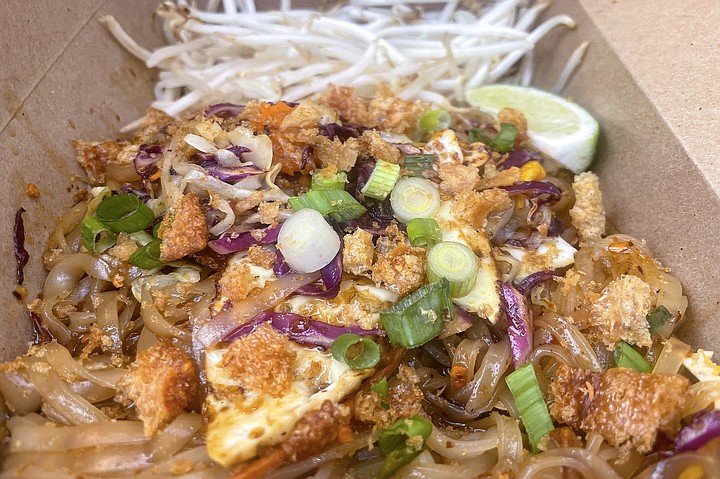
The other big difference shows up when you select your proteins. Like the market stand, the storefront offers each pad thai order with a choice of chicken or vegetables for $12, or shrimp for $13. However, the storefront adds the option for tofu ($12), which apparently doesn’t hold up well to sunny farmers market days, but which I actually prefer to the chicken.
But more interesting proteins may be found on the daily specials board. One I spotted for $21 included an abundance of seafood: shrimp, mussels, scallops, calamari, and fish balls. Another for $19 topped the pad thai with lobster meat!
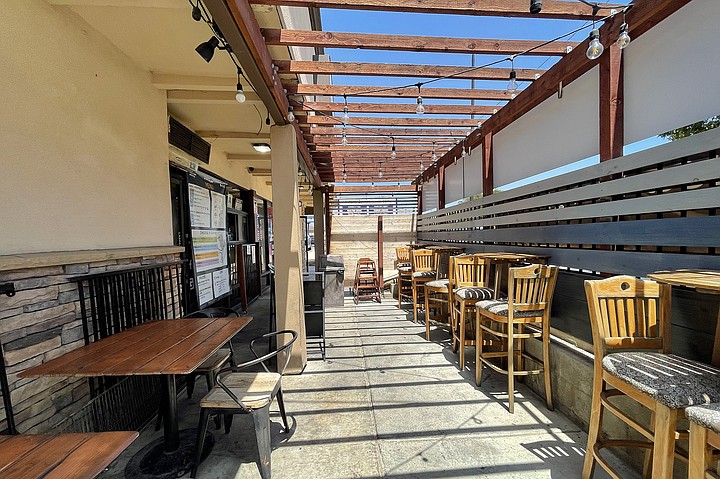
The Pad Thai Stand storefront happens to be the same spot that was previously home to a different Thai street food operation — Thai Burger Company — which I’d checked out around the same time I first tried these noodles. It’s not an impressive location — really just a small ordering window facing narrow strip of patio at the end of a crusty old shopping center.
But chef Nat and company did a commendable job upgrading that patio, enclosing it in wood, stringing up a few lights, and putting in a mix of low and high-top outdoor seating. It’s well suited for street food, and a fine perch for keeping an eye on a still-evolving menu representing the Thai national dish.


It had been a few years since I sought out a certain pad thai farmers market stand to receive a tasty lesson in Thai street food, and I felt overdue for a refresher course. However, I wasn’t sure where. Farmers market food vendors tend to bounce around. They’ll pop up at different weekly markets around the county, maybe just for a few weeks, or regularly for years — whatever best serves its business.
Only when I tried to pinpoint the current markets hosting The Pad Thai Stand did I realize that, sometime during the pandemic, the Thai noodle specialist had set up shop in a permanent, Clairemont Mesa location.
Pad Thai Stand still turns up at several farmers markets each week, including Oceanside, Del Mar, Pacific Beach, and the Sunday market at Lane Field, next to the waterfront. And its mission remains the same: to highlight the many possibilities of the humble pad thai. Though the Bangkok style is a staple of nearly every Thai restaurant in the U.S., the Stand’s founding chef Nattapon "Nat" Thitathan continues to travel Thailand to delve into dozens of regional variations, with an eye toward introducing distinctions to a local audience.

There’s no reason to feel overwhelmed, though. Only a handful of regional styles appear on the menu at Clairemont Mesa. In fact, at first blush, its offerings don’t appear all that different from the market stand.
You’ll find the central, Bangkok style we can think of as a base for pad thai, delivering a blend of tamarind paste, citrus, and fish sauce over rice noodles with egg, sprouts, and chili peppers to taste (from mild to spicy). Then, there’s the northern, Chiang-Mai style, embellished with peanut sauce and massaman curry; and the southern, Chai-Ya style, distinguished by coconut cream and crispy shallots.

For $2 apiece, add-on toppings may include fried garlic, dried shrimp, or preserved sweet radish. For vegans and vegetarians, the base sauce for all three may be swapped for an Ayutthaya sauce (also $2) which replaces the anchovy fish sauce with additions of soy sauce and cranberries.
Where the storefront restaurant starts to deviate from the market stand is the addition of a fourth, boran style, which means it’s “old style” pad thai. This one starts with a black soy sauce, reduced in the pan, and gets topped differently, with both green and yellow beans, plus pork rinds. The mild sweetness brought by the soy pairs particularly well with the chili peppers, so I’d recommend it for heat-lovers who want to order in the medium and hot spice range.

The other big difference shows up when you select your proteins. Like the market stand, the storefront offers each pad thai order with a choice of chicken or vegetables for $12, or shrimp for $13. However, the storefront adds the option for tofu ($12), which apparently doesn’t hold up well to sunny farmers market days, but which I actually prefer to the chicken.
But more interesting proteins may be found on the daily specials board. One I spotted for $21 included an abundance of seafood: shrimp, mussels, scallops, calamari, and fish balls. Another for $19 topped the pad thai with lobster meat!

The Pad Thai Stand storefront happens to be the same spot that was previously home to a different Thai street food operation — Thai Burger Company — which I’d checked out around the same time I first tried these noodles. It’s not an impressive location — really just a small ordering window facing narrow strip of patio at the end of a crusty old shopping center.
But chef Nat and company did a commendable job upgrading that patio, enclosing it in wood, stringing up a few lights, and putting in a mix of low and high-top outdoor seating. It’s well suited for street food, and a fine perch for keeping an eye on a still-evolving menu representing the Thai national dish.
Comments